

Real Data – Real Issues what they never told me at Uni Phil Brierley WOMBAT 18 th February 2016
Data Prep v Predictive Modelling Time wise… 80% - Data Prep 5% - Model Building 50% - Explaining results Data Scientists like to over deliver!
• Model building is now becoming a point and click commodity • ‘Correct’ data preparation will never be this • Rubbish in – Rubbish out • Caveat Emptor let the buyer beware
• Knowing your data is the most important thing • Don’t listen to ‘expert opinion’ • The data contains all the questions the ‘experts’ may have the answers
This talk is nothing to do with Maths, Statistics or Algorithms Its to do with the 90% of your time you will spend getting your data ‘Algorithm Ready’
4 Steps 1. Getting the Data – Receiving the data Getting the 2. Sanity Checking the Data data – Is it consistent? ‘Algorithm Ready’ 3. Preprocessing the Data – Don’t introduce issues But we’ll 4. Predictive Modelling talk a little – Last 5 mins of project timeline & budget! on this
1. Getting the Data A long process - but can be made less painful
Getting the Data • Can involve 2 or 3 iterations if its not extracted correctly • This can be avoided by specifying exactly how you want it
Getting the Data • Raw data only – We’ll do any aggregation – Quicker for us and you – We need to know what has gone on • All the data (size permitting) – We’ll decide what populations not to use – Maybe only filter on time – Much quicker, storage is cheap – Not saving us or you any time by doing filtering your end
Getting the Data • Database dump if possible – Detach database, we’ll reattach – Ensures our ‘solution’ can be run in your production environment ( thinking ahead! ) • Delimited Text Files – Pipe delimited (|) – No quotes around text fields
Getting the Data • EXCEL – Excel generally means humans involved – BAD! – Hard to replicate exactly what has gone on (see above) – Excel does weird stuff (see later) – Source data won’t be Excel (hopefully) – Putting it in Excel to ‘help us’ is not actually helping (the first thing we do is try get it out of Excel)
2. Sanity Checking Identifying Systematic Data Issues Data driven predictive modelling assumes the future will be like the past – we need to make sure the past is like the past
1. Acquisitions and Events Health Insurer June 2,000 - lifetime health cover (change in govt. policy) New acquisition Members Time (months) >>
1. Acquisitions and Events Company Financial Statement Dates ‘made up’ data ! Number of Reports Date >>
2. Made up Dates Company Financial Statement Times After Market Close Before Market Open Market Open Year Time of Day >>
2. Made up Dates Date of Announcement >>
2. Made up Dates Electricity Consumption Sometimes fudged ! 2am clock change
2. Made up Dates • Always look at date distributions • Dates usually cannot be ‘null’ in a database • Thus common to see system default dates • Happens when data sources are ‘merged’ or dates are unknown
3. Moving Definitions Health Insurance Claims – time lags non Medicare hospital hospital Non- Medicare Data gets updated non retrospectively hospital once all claims are received hospital Date >>
3. Moving Definitions Hospital Admissions Number of Admissions What is the reason for this? Date >>
3. Moving Definitions Number of Admissions for Congenital Heart Disease Admissions Has Congenital Heart Disease suddenly been cured? Date >>
Number of Admissions to Emergency Dept. 3. Moving Definitions 1 st July Date >>
3. Moving Definitions
4. Data Capture Bias Volume of Trades – Exchange reporting policy (Share Splits) Only ‘odd lots’ Minimum recorded prior Volume to 2014 Data thus biased towards lower priced shares - dependent on volume of shares, not $ amount Date >>
5. Real or Systematic ? Discharge Times from Hospital (you don’t actually clock out!) Time of 6pm Non - Chemotherapy allocated to everyone Chemotherapy Time of Day
6. System Overrides Looks OK? Freq Exam Mark
6. System Overrides Hmmm! What do you think the pass mark is? Freq Exam Mark
3. Pre-processing data Avoid Self Imposed Coding Errors
1. Integer Division
1. Integer Division Documented – but who reads documentation!
2. Floats & Reals Comparisons of numbers dependent on format
2. Floats & Reals It is documented !!
3. Nulls Null is ‘unknown’ – so any calculation on records containing a Null correctly returns Null (not necessarily intuitive)
3. Nulls Technically correct as NULL means ‘I don’t know’ …but none the less, not what you might be expecting
4. Nulls (again) The disappearing record Records = 5 Yes = 2 Not Yes = 2 2 + 2 != 5 (not intuitive)
5. Nulls (again, again) Beware Function Defaults
5. Nulls (again, again) This genuinely caught me out!
6. Beware software quirks - the midnight hour (caught me out again!) Bang on midnight the seconds disappear
7. Stay away from Excel !! • 1-3 • Excel will convert it to 3-Jan • Convert cell to text and it becomes 42007 • mm/dd/yy or dd/mm/yy • Phil's Rules – avoid Excel as it has a mind of it’s own. – data used for modelling should go nowhere near Excel
8. Damn Smileys! (damn Microsoft)
4. Predictive Modelling If it looks too good to be true – it normally is
Predictive Modelling • These days, all you need to know is: – Ensembling – Over fitting (or how to avoid it) – Calculating Variable Importance • Helps detect information leakage
If it’s too good to be true… 1. University Attrition (voluntary or involuntary) 2. Insurance Claims (level of cover) 3. ID is a proxy for the outcome (kdd Cup)
Thank you for listening
Recommend
More recommend